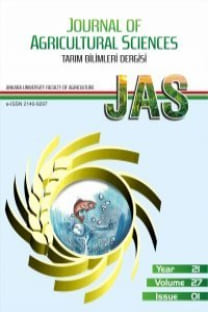The Effect of Adding Corn Silage at Different Ratios to Orange and Tangerine Wastes on Biogas Production Efficiency
Orange wastes tangerine wastes, corn silage, biogas, HBT,
___
- Amon T, Amon B, Kryvoruchko V, Zollitsch W, Mayer K & Gruber L (2007). Biogas production from maize and dairy cattle manure—Influence of biomass composition on the methane yield. Agriculture, Ecosystems & Environment 118(1): 173-182
- AOAC (1990). Official Methods of Analysis. 15th ed. Association of Official Analytical Chemists, Washington, DC, USA
- Çallı B (2012). Atıklardan Biyogaz Üretimi. Türkiye Kimya Derneği -Genç Kimyacılar Platformu, http://eng.marmara.edu.tr/enve
- Elaiyaraju P & Partha N (2012). Biogas production fromco-digestion of orange peel waste and jatropha de-oiledcake in an aerobic batchreactor. African Journal of Biotechnology 11(14): 3339-3345
- FAO (2015). FAO Statistical Yearbook 2013. World food and agriculture. www.fao.org. (02.22.2015)
- Gunaseelan V N (2004). Biochemical methane potential of fruits and vegetable solid waste feedstocks. Biomass and Bioenergy 26(4): 389-399
- Heffrich D & Oechsner H (2003). Comparison of Different Lab¬oratory Techniques for the Digestion of Biomass. Landtechnik 9: 27-30
- Nguyen H (2012). Biogas Production from Solvent Pretreated Orange Peel. Master Thesis, Chalmers University of Technology, Department of Chemical and Biological Engineering
- Özmen P (2009). Biogas production from municipal Wastemixed with different portions of orangepeel. Master Thesis, Universty of Boras, Applied Biotechnology
- TUİK (2015). Türkiye İstatistik Kurumu. http://www.tüik.gov.tr (Access date: 02.22.2015)
- Üçok S, Aybek A & Yıldız K (2016). Elma ve şeftali atıklarının biyogaz değerlerinin deneysel olarak belirlenmesi. 1st International Mediterranean Science and Engineering Congress (IMSEC2016), October 26-28, Adana, Turkey, pp. 437–444
- Van Soest P J, Robertson J B & Lewis B A (1991). Methods for dietary fiber, neutraldetergent fiber, and nonstarch polysaccharides in relation to animal nutrition. Journal of Dairy Science 74: 3583–3597
- VDI 4630 (2006). Fermentatıon of organicmaterial, characterisation of substrate, collection of material data, fermentation tests, VDI Gesellschaft Energietechnik
- Wikandari R, Millati R, Cahyanto M N & Taherzadeh M J (2014a). Biogas production from citrus wasteby membrane bioreactor. Journal of Membranes (4): 596-607
- Wikandari R, Nguyen H, Millati R, Niklasson C & Taherzadeh M J (2014b). Improvement of biogas production from orange peel wasteby leaching of limonene. Hindawi Publishing Corporation Bio Med Research International 2015(10): 1-6
- Yayın Aralığı: 4
- Yayıncı: Ankara Üniversitesi Basımevi
Ali AYBEK, Serdar ÜÇOK, Metin DAĞTEKİN, Abdullah BEYAZ
Fatma KAYAÇETİN, Fadul ÖNEMLİ, Güngör YILMAZ, Ahmet KINAY, Halil HATİPOĞLU, Mehmet Niyazi KIVILCIM, Nimet KARA, Arzu KÖSE, Fırat SEFAOĞLU
Hasan Murat AKSOY, İslam SARUHAN, Yilmaz KAYA, Murat OZTURK
Aflatoxin Contamination in Hazelnut Oil Obtained from Hazelnuts Containing High Levels of Aflatoxin
Elif APAYDIN, Rıdvan İLGÜN, Ümit ŞENGÜL, Bünyamin ŞENGÜL, Enis TAŞÇI
Ahmet Erhan Özdemir, Elif Çandır
Özay BALTAER, Mustafa ÜNLÜ, Ömer ARSLAN, Veysel ARAS, Ahmet Erhan ÖZDEMİR, Halit YETİŞİR, Elif ÇANDIR, Durmus ÜSTÜN
